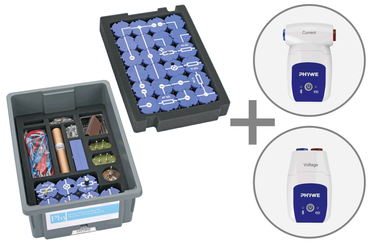Principle
Faulty insulation can result in voltages on parts of appliances that are not intended to carry current.
Dangerous voltages occur most frequently on metal casings of electrical appliances. To exclude the possibility of danger to people using such appliances, a safety lead is installed that is connected to the N-lead of the household electric circuit. A short circuit then results when, for example, there is a voltage on the metal casing of an appliance. The safety fuse is triggered.
Benefits
- No additional cable connections between the building blocks needed - clear arragned and quick setup
- Contact saftey due to puzzle blocks system
- Corrosion-free gold plated contacts
- Doubled earning sucess: Electric circuit diagram on top, real components can be seen unterside
Tasks
How is it possible to prevent dangerous voltages from occurring on conductive casings of electrical appliances?
Set up an electric circuit with a safety fuse, switch, filament lamp and casing. Use the person model to examine the function of a safety lead.


